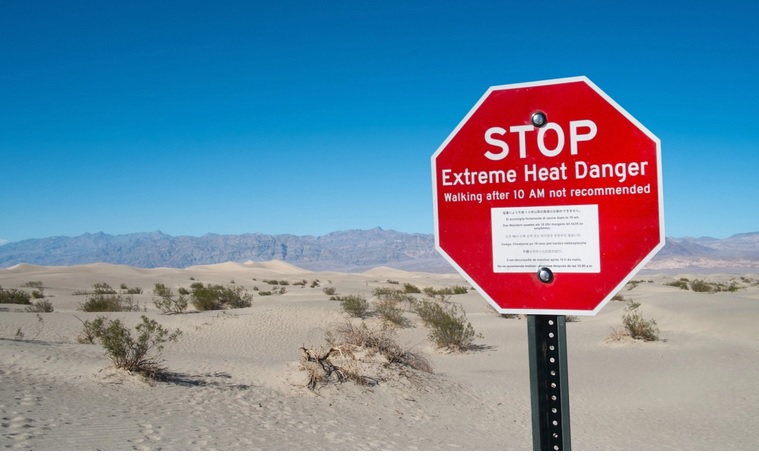
Another heat dome is building over the Western United States, more records are expected to shatter and unfortunately, there may well be more deaths too.
While hurricanes, floods, tornadoes, and blizzards often take the headlines when it comes to weather-related deaths, it is actually heatwaves that kill the most people. As many as 12,000 people in the U.S. may die from heat each year. According to coroners in British Columbia, at least 808 people died in the Canadian province’s record-breaking heatwave at the end of June. And at least 200 people died across Washington and Oregon. In Hermiston, Oregon, a worker at a Walmart distribution center collapsed while working in an unairconditioned trailer and later died. And in St. Paul, Oregon a 38-year-old farmworker died after moving irrigation lines at a plant nursery on a day that temperatures hit 105. In Oregon, the youngest person who died from the heat was 38 and the oldest was 97, according to state officials. The average age was 66.
Digital Dying has posted a number of blogs about death and extreme cold. We even wrote about the Russian town of Oymyakon, in eastern Siberia, considered the coldest town on earth, where the average high temperature in January is -45 Fahrenheit and school is only canceled when temperatures go below -62 Fahrenheit.
But we have written about extreme heat too. In fact, in a 2017 post, we cited research by the American Geophysical Union. “We show that heat stress…is projected to rapidly and dramatically increase and that by mid-century crippling summertime conditions are possible across some of the most densely populated regions of the planet,” researchers stated. “By the end of the 21st century, the habitability of some regions of the planet may be questionable due to heat stress alone.”
At the time, DARA, a Spanish non-profit, predicted that by 2030 there will be “close to 700,000” deaths a year due to climate change. And the World Health Organization predicted that between 2030 and 2050, “climate change is expected to cause approximately 250,000 additional deaths per year.” A 2016 research article published by the Lancet, a British medical journal, estimated that by 2050 climate change could kill more than 500,000 people a year globally.
What once seemed like a difficult to conceive and slightly alarmist message is just several years later appearing to become more and more of a reality. But just what is it about the heat that kills, and exactly how does heat kill?
“Hot weather alone is not dangerous,” explains a 2012 LiveScience article, quoting environmental physiologist Chris Minson. “Instead, it’s a combination of hot temperatures, high humidity, and often pre-existing health conditions.” The normal human body temperature is about 98.6 Fahrenheit, but these factors can push that temperature up to 104 Fahrenheit, considered the danger zone. “At that point,” the article continues, “the nervous system goes haywire, the heart experiences excessive stress, and organ systems begin to fail.”
Kristie Ebi, a professor of global health at the University of Washington, explained recently to NPR that it often comes down to sweating. Sweating allows our body to discharge heat via evaporation. Beads of water form on your skin and as air draws them away heat is pulled away too, leaving our body cooler as a result. But if the air is very humid, less sweat is able to evaporate off your body into the already water-rich air, and the body’s favored cooling method fails. This is why 80 degrees in humid New Orleans feels a lot hotter than 100 degrees in arid Las Vegas. One can do a simple experiment to test this out, lay a sopping wet towel on a line and measure how many hours it takes to dry—in New Orleans you might be counting in days. Now imagine this towel as your skin!
“What should we expect in the coming years?” NPR asked Ebi. “I mean, are these events likely to be more common?”
“We know from the climate science that climate change is increasing the frequency, the intensity, and the duration of heatwaves,” the researcher replied. “We also have seen over the last few years very extreme heat waves in Siberia. There was a heatwave in Japan that the Japanese meteorological authority said couldn’t have happened without climate change. Northern Scandinavia, Sweden, a couple of years ago had a heatwave with 700 excess deaths. So we’re seeing these around the world.”
Indeed, in recent weeks temperatures in Turkey and North Africa approached 122 Fahrenheit, according to Bloomberg. And Finland experienced 31 consecutive days with maximum temperatures above 25°C, the longest heatwave ever recorded in the country. Emergency rooms filled up, mostly with people suffering from dehydration and cardiac issues. And in Japan, some events for the Summer Olympics have had to be moved to cooler locations in the country because of the heat in the Tokyo area, and at least one athlete collapsed because of the heat.
In Russia in 2010, an estimated 56,000 people died from the effects of a prolonged heatwave. And the European heatwave of 2003 resulted in 14,000 deaths in France alone.
But in the end, no matter which country, it is always the most vulnerable who face the greatest risks.
And of course, resources and access to cold play a role. The New York Times reported that many of the heat deaths in the Pacific Northwest were among homeless people and those who were older or had medical issues. Vivek Shandas, a researcher who studies cities and climate at Portland State University explained to NPR in a separate story that, “Places that were historically disinvested, or currently not really invested areas, are some of the hottest places in Portland.” He set up thermometers around Portland and checked them during the extreme heat and found a big disparity between more affluent, leafy neighborhoods — which registered about 98 degrees Fahrenheit — and others with more highways, parking lots and industrial plants, which soared as high as 124 degrees. Many of the people who died in the Portland area were older, with underlying health conditions. And many were found home alone, without air-conditioning or a fan.
But the highest temperatures Shandas recorded were at homeless encampments. “Those were about 135 degrees, and that is clearly enough to kill somebody if you’re exposed to that,” he says. Another problem is that the temperature has not been dropping at night, which typically provides relief for overheated individuals. “Nighttime is one of the most potent times where people die of heat exhaustion,” Shandas said. And data indicates that nights are actually warming even faster than days.
“Think about who contributed to climate change over the last century, and who is seeing the most consequences today, and you see it is not fair,” Tarik Benmarhnia, an environmental health expert at the University of California, San Diego, told National Geographic. “There is a huge environmental injustice in terms of who is suffering the heat-related mortality caused by anthropogenic climate change.”
One question that emerges when a heatwave quickly and unexpectedly kills hundreds or even thousands of people in the same city or region is what to do with all of the bodies.
In France’s heatwave in 2003, CNN reported that funeral homes had to build their own coffins on the spot as morgues overflowed. City officials organized temporary burials in paupers’ graves to relieve pressure on their overburdened funeral services and Jean-Paul Proust, chief of police for Paris, explained to reporters that the city would bury all corpses left unclaimed for 10 days. “These corpses will not be buried in a common grave,” he stated, denying a local press report that unclaimed bodies would be dumped into secret mass graves. Rather, special concrete-lined graves would be marked, and families could have the caskets exhumed for a proper reburial elsewhere at a later time.
Meanwhile, in the recent heatwave in the Portland area, local news reported that the sheer quantity of calls during the height of the heatwave meant the medical examiner could not go to every site to investigate, as is typically the case when someone dies at home alone. In British Columbia, a backlog was reported at funeral homes. “We went full tilt,” Zane Green, owner of Ancient Burials, Funerals, and Preplanning, told a local TV news station. Green said that while his funeral home could still offer services for families upon request, the morgue was slammed and there were delays in transportation and the retrieval of bodies. He said he hoped residents of the city would not only appreciate the efforts of first responders in the crisis but also what he called, the “last responders.”
But there is some good news. It turns out that many of the people who die of heat-related stresses often die alone, which is another issue that Digital Dying has covered in detail—see our long list of posts on the topic of “lonely death”. This means that an easy way to provide comfort is to simply check in on folks, and look after one another. And remember, eventually autumn will come. Stay cool out there everyone!









